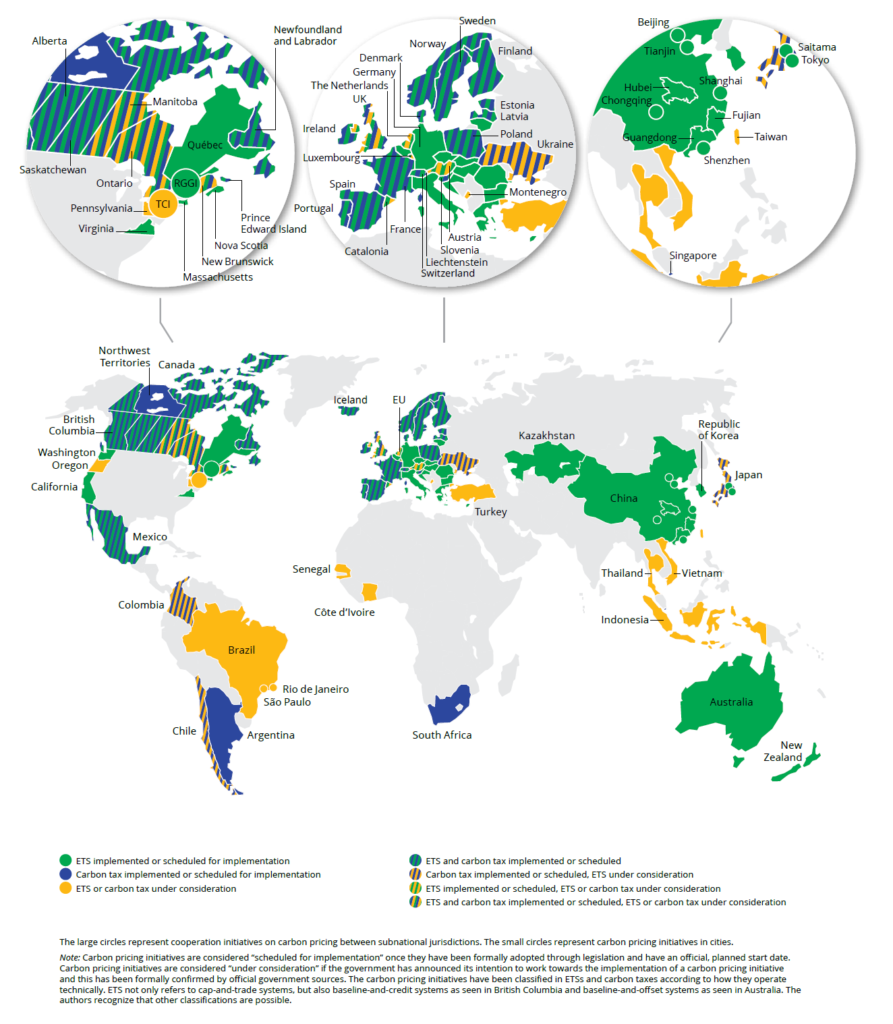A post by Simone Lucatello, Senior researcher at Instituto Mora and Coordinating author of the IPCC for the next climate change Assessment Report (AR6)
Over the past few years and under the Paris Agreement reduction pledges, many countries in the world have adopted carbon pricing initiatives and climate policy tools in order to increase their emissions ambitions, declaring a “climate emergency” status for the planet. According to recent figures from the World Bank in the “2020 Report on States and Trend of Carbon markets”, there are currently 61 carbon pricing initiatives already working and some others ready for implementation, consisting of 31 Emission Trading Systems (ETSs) and 30 carbon taxes, covering 12 Giga-tons of carbon dioxide equivalent (GtCO2e) or about 22% of global GHG emissions. Among the Latin American countries, Mexico started the ETS implementation in 2020.

Source: State and Trends of Carbon Pricing 2020, World Bank
Mexico is the world’s 10th largest emitter of greenhouse gases (GHG) and the 11th world economy and it is expected to be the seventh largest economy by 2050 (PWC, 2019). Total GHG Mexican emissions in 2019, excluding carbon sequestration, were 789tCO2e, approximately 1.8% of total global emissions. The most important contributors to GHG in Mexico are transportation, electricity generation and industry: major emitters, along with the private sectors, are government owned companies like Pemex, the National Oil Industry and the CFE, the Federal Commission for Electricity. (Climate Tracker, 2020)
In 2012, Mexico’s Congress passed the General Law on Climate Change (LGCC), which entered into force that same year. The law and other national mitigation instruments like the National Program for Climate Change (PECC), set a target for a 30% reduction in GHG emissions by 2020, and a 50% reduction below 2000 levels by 2050. Since the law inception in 2012, Mexico has been evolving in its commitment to climate change mitigation and adaptation policies by introducing new internal governance mechanisms like the climate planning instruments, which broadly include the following: the National Climate Change Strategy (ENCC) 10-20-40, which provides short, medium and long term vision on climate national efforts to reduce emissions. Second, the Special Climate Change Program 2014-2018, provides an instrument that links national priority targets with mitigation and adaptation efforts at federal level but also at state and municipal level. (IETA, 2018). A new Special Climate Change Program is also expected to be published by 2021.
Mexico was also the first emerging economy to submit its Intended Nationally Determined Contribution (INDC) to the UNFCCC in 2016. Mexico’s INDC recalls the need to improve international market mechanisms to reach quick and cost-effective mitigation. Mexico ratified the Paris Agreement in April 2016, and the country is aiming to hit a non-conditional target of 22% GHG emission reductions and the conditional target of a 36% reduction by 2030 based on the INDC targets submitted. (SEMARNAT, 2019)
Under the current political administration (2018-2024) led by President Andrés Manuel López Obrador, the LGCC mandates that the government develop an updated Climate Change Program and introduce new carbon price mechanisms. The government is currently defining well-suited policies and measures for achieving these targets. Through the 2018 reform to the general climate change law, the Mexican Ministry of Environment has been given the mandate to establish an Emissions Trading System (ETS) in the country. The regulation for the ETS pilot program was published in October 2019 and the program started operation in January 2020. It will last until December 2021, before entering a one-year transition period while the formal phase of its functioning and implementation is set to begin in January 2023.
In July 2020, Mexico launched the National Environmental Sectoral Plan 2020-2024 that is the main political instrument for governing environmental public policies, including climate change mitigation and adaptation efforts. The plan is made up of 5 main goals, among which the second one states that the plan will promote “the implementation and strengthening of climate actions aiming to reach a low-carbon economy and resilient societies, ecosystems and infrastructure based on scientific knowledge, local traditions and available technologies” (SEMARNAT, 2020). Under this pillar, climate initiatives such as the ETS find a legal basis to continue with previous decade-long efforts to tackle climate change in Mexico and worldwide.
In this brief overview of policy instruments, it is also worth keeping in mind that significant changes in Mexican regulatory policy outputs for the energy sector occurred during the period 2013-2018 under President Peña Nieto. Negotiations over the 2013 Energy Constitutional Reform Bill went fast, being approved by both legislative chambers at the end of December 2013. The bill was the subject of extensive support from international organizations such as the OECD and the US government, which recognized the relevance of the reform to its own energy security and fossil fuel exploitation. (Echeverria Victoria and Banuelos-Ramirez 2017, Vargas 2015). For example, it included a mandate for Congress to approve a legal framework to establish the basis for achieving environmental protection through the incorporation of criteria and best practices regarding energy efficiency, GHG reductions and lower carbon footprints in energy-related processes (Cámara de diputados 2018). However, the bill’s main aim was to increase the production of oil and gas through private investment, something potentially inimical to climate change mitigation, since meeting the goals of the Paris Agreement implies that significant portions of the world’s fossil fuel reserves remain undeveloped. Hence, in contrast with previous laws, the 2014 hydrocarbon law does not include provisions to reduce gas flaring and venting during oil and gas extraction, even though this is the main source of CO2 emissions associated with offshore oil extraction (García-Lucatello, 2020).
With the new administration of President Lopez Obrador, which clearly intends to take some distance from previous neo-liberal economic administrations, important reviews of the main energy law and other mechanisms is under profound scrutiny. It remains to be seen how the current legislative changes by the government and the above highlighted controversial issues may affect the settings for the Mexican ETS implementation and its continuity.
This blog post originates from a forthcoming book edited by Simone Lucatello and titled “Towards an Emissions Trading System in Mexico: rationale, design and connections with the global climate agenda“. The book will be published by Springer with the support of GIZ in Mexico.
The views and opinions expressed in this post are solely those of the author(s) and do not reflect those of the editors of the blog of the project LIFE DICET.

